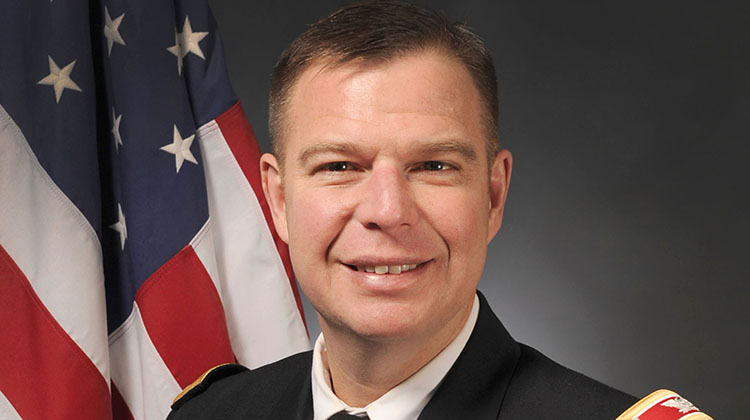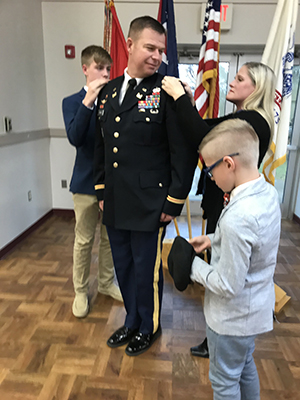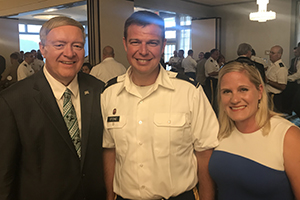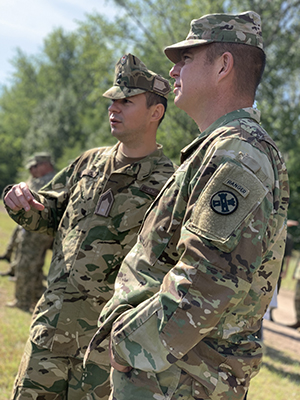Alumnus coordinating state’s plans to convert facilities into alternate medical care sites

Col. Andrew Stone, MS ’13, is one of hundreds of Ohio National Guard members activated in recent weeks to help support the state’s humanitarian and logistical response to the COVID-19 pandemic. Commander of the Ohio Army National Guard’s 16th Engineer Brigade, Stone is leading statewide efforts to identify facilities that can be converted into temporary medical care sites. Photo courtesy of the Ohio National Guard. Disclaimer: It is not the intent of Ohio University to imply an endorsement by any service branch of the U.S. Armed Forces.
Col. Andrew Stone, MS ’13, helped with disaster response in Louisiana following 2008’s Hurricane Gustav and in the Philippines in 2013 following that country’s deadliest typhoon on record. He has deployed to Iraq twice – as an Army paratrooper during Operation Iraqi Freedom in 2003 and again in 2005 as a member of the Ohio National Guard.
And, as this Ohio University civil engineering graduate prepares to deploy to the Middle East again this June, he now finds himself serving on the frontlines of Ohio’s battle against the global COVID-19 pandemic: leading statewide efforts to identify facilities that can be converted into temporary medical care sites.
Stone is the commander of the Ohio Army National Guard’s 16th Engineer Brigade and also serves as the service-safety director for the city of Athens. He went on active duty on March 30, assigned to oversee the state’s Joint Engineering Assessment Teams (JEATs) who are working with local and regional emergency responders and health care systems to prepare for the anticipated surge of COVID-19 patients in the coming weeks.

The family of Col. Andrew Stone, including (from left) son AJ Stone, wife Tanyah Stone and son Walker Stone, participate in a December 2019 pinning ceremony at the Athens Community Center. The ceremony, held in honor of Stone’s promotion to the colonel rank, was attended by many of Stone’s colleagues from the city of Athens, the Ohio Army National Guard and Ohio University President M. Duane Nellis. Disclaimer: It is not the intent of Ohio University to imply an endorsement by any service branch of the U.S. Armed Forces.
“The scale of this, from a disaster response perspective, is something that we have not encountered before,” Stone said in an April 3 interview as he was traveling from the Ohio National Guard Joint Forces Headquarters in Columbus to Chillicothe to meet with emergency responders in the state’s southeast region. “And, the speed with which we’ve had to pull together the various resources of the state to very quickly create an organizational structure that can function is the biggest challenge.”
In every corner of the state, JEATs, composed of Ohio Army and Air National Guard officers and service members with special training and expertise in engineering and construction, have been assessing potential alternate care sites. Their work, evaluating each location’s suitably, feasibility and the estimated cost of converting it to an alternate care site, is being done in partnership with the U.S. Army Corps of Engineers, the Ohio Department of Health, the Ohio Emergency Management Agency, the Ohio Department of Transportation, the Ohio Facilities Construction Commission, and the Ohio Department of Administrative Services.
“This is not a Guard-led effort,” Stone emphasized. “Whereas we are driving the process, ultimately it’s pulling from the local hospital systems and the local and regional EMA personnel to select sites that make the most sense and can support the regional medical system that exists. … It’s a tremendous amount of coordination.”
The site assessments follow models provided by the U.S. Army Corps of Engineers, which developed templates for how to convert convention centers, stadiums and hotels into health care facilities as well as templates for the awarding of contracts to convert selected facilities. Once a site is approved for conversion, contracts will be awarded for any needed construction as well as to supply the site with beds and other medical equipment.
As of Friday morning, Stone said the Ohio National Guard JEATs had visited about 12 sites and were zeroing in on five locations in some of the state’s largest cities – Cincinnati, Cleveland, Columbus, Dayton and Youngstown – to convert to alternate care sites.
“I am interacting with officials at the state and local level in order to determine how we’re going to modify these facilities,” Stone said. “We really only have a couple of weeks to get this right before the surge is here.”
It’s a race against time, uncertainty and a virus that, as of April 6, has infected more than 1.2 million individuals in over 200 countries and killed more than 70,000 worldwide.
In his more than 20 years of military service, Stone has only one prior experience responding to a pandemic – in 2009 when the Ohio National Guard was preparing to help distribute Tamiflu to local health departments during the H1N1 pandemic. “It never ended up coming to that point,” he said.

Andrew and Tanyah Stone pose for a photo with Ohio University President M. Duane Nellis during a July 2018 event at the Army War College in Pennsylvania where Andrew completed a master’s degree in strategic studies and earned the title of distinguished graduate. Disclaimer: It is not the intent of Ohio University to imply an endorsement by any service branch of the U.S. Armed Forces.
Stone’s military service began as an undergraduate at The Ohio State University where he joined the Army Reserve Officers Training Corps. In 1999, he went on active duty, serving as a paratrooper in the Army’s 307th Engineer Battalion, 82nd Airborne Division and earning several U.S. and foreign awards and decorations, including two Bronze Star Medals and three Meritorious Service Medals.
In the fall of 2003, Stone left the active component of the Army, moving to the Ohio National Guard and to Southeast Ohio where today he serves as Athens’ service-safety director, overseeing the city’s police and fire protection, code enforcement, public works, information technology, parks and recreation, and other essential services.
As a member of the fourth largest National Guard in the country, Stone serves in the reserve component of the U.S. Armed Forces, training soldiers for war and working in military engineering and deployed settings, and as a member of the governor’s domestic response team, providing resources and expertise in times of conflict and disasters.
“The state of Ohio is very good at dealing with disasters,” Stone said, “but the disasters we’re used to dealing with are things like flooding along the Ohio River or tornadoes in Northwest Ohio or snowstorms – things that are kind of finite and geographically constrained. This is wide-ranging. It’s across the entire state, and there’s a lot of ambiguity about what will happen.”
The days spent preparing the state for COVID-19 are long and heavy, given the weight of what’s at stake, but Stone has found uplifting moments as he witnesses state officials and emergency responders setting aside everyday bureaucracy to formulate a comprehensive, coordinated and timely response plan.
“Everybody has the sense of urgency that Governor DeWine has imparted to us,” Stone said. “That sense of urgency has spread throughout the entire state government, and you can feel it when you talk to everybody. They all know that this peak is coming, and when the peak comes, we will be so much more successful if we are able to put in place these alternate care facilities to accept overflow patients as opposed to dealing with situations where hospitals are overwhelmed and may have to make decisions about life and death.”
A 2013 graduate of OHIO’s Russ College of Engineering and Technology where he earned a master’s degree in civil engineering, Stone is one of many members of the Ohio University community contributing to the Ohio National Guard’s efforts to support the state’s humanitarian and logistical response to the COVID-19 pandemic.

Col. Andrew Stone (right) is seen last fall with a Hungarian soldier in Hódmezővásárhely, Hungary. Stone was one among several Ohio National Guard members who observed and provided guidance to a multinational exercise that included participants from Hungary, Slovakia, Ukraine, Austria and Romania. Disclaimer: It is not the intent of Ohio University to imply an endorsement by any service branch of the U.S. Armed Forces.
Last week, Stone was working with fellow Bobcat and Ohio Army National Guard Capt. Nick Mossbarger, BSRS ’11, who is leading one of the state’s JEATs. Joseph Gabriel, BA ’92 and a student in the Voinovich School of Leadership and Public Affairs’ online Master of Public Administration Program, is the director of government and public affairs for the Ohio National Guard. More than 100 volunteers from OHIO’s College of Health Sciences and Professions, including faculty, students and alumni, are working with the Ohio Department of Health and the Ohio National Guard to assist local health jurisdictions as they respond to the COVID-19 pandemic. Peter Kirkendall, a student in the College of Business’ Online MBA Program with a concentration in health care, is a member of the Army and has been deployed to New York to assist in that state’s COVID-19 response efforts.
Spc. Tim Springer, an OHIO junior majoring in civil engineering, is one of approximately 500 Ohio National Guard and Ohio Military Reserve members who are helping to support 12 foodbank warehouses across the state, sorting, packing and delivering food.
“I have been placed outside, helping to check families in and loading groceries into cars,” said Springer, one of about 100 Ohio National Guard members providing assistance at the Mid-Ohio Foodbank in Grove City. “I am very happy to have signed up for this. The looks on people’s faces are priceless as we fill their cars. The National Guard is always ready to help where needed, and we are happy to help.”
Springer estimated that the Mid-Ohio Foodbank had distributed 460,000 pounds of food to those in need in the past two weeks.
“This situation is extremely serious,” said Stone, “but we are winning, and we are winning because the state of Ohio has taken it seriously and has done what it needed to do to deal with something that none of us has ever faced in our lifetime.”
For information about Ohio University’s COVID-19 action plan and response, visit https://www.ohio.edu/coronavirus. For information on Ohio University’s Bobcats Take Care campaign, which is supporting, connecting and engaging OHIO alumni and students while addressing immediate student needs, click here.
